Physical Address
304 North Cardinal St.
Dorchester Center, MA 02124
On completion of this chapter, you should be able to:
List the causes of and risk factors for pelvic inflammatory disease
Describe the sonographic findings of salpingitis, pyosalpinx, tubo-ovarian abscess, endometrioma, and adenomyosis
Identify the locations of endometrial implants in the body
Explain the development of endometritis in the postpartum patient
Discuss the role of ultrasound in pelvic inflammatory disease
Pelvic inflammatory disease (PID) and endometriosis are diffuse disease processes of the female pelvic cavity. Most commonly, PID is caused by sexually transmitted diseases, including gonorrhea and chlamydia. Although uncommon, PID can also be caused by a ruptured appendix and peritonitis. PID and endometriosis have very different clinical presentations and pathologies. However, early in the disease, the clinical presentation of both endometriosis and PID is nonspecific and may mimic functional bowel disease.
PID is an inclusive term that refers to all pelvic infections (e.g., endometritis, salpingitis, hydrosalpinx, pyosalpinx, periovarian inflammation , tubo-ovarian complex , and tubo-ovarian abscess). The infection usually occurs bilaterally and may be found in the endometrium ( endometritis ) , the uterine wall ( myometritis ) , the uterine serosa and broad ligaments ( parametritis ) , the ovary ( oophoritis ) , and the most common location, the oviducts ( salpingitis ) ( Fig. 45.1 ). Sonography has limited value during acute PID or at early onset when inflammatory changes have not yet begun to manifest. In cases of chronic PID, ultrasound can identify dilated fallopian tubes (hydrosalpinx or pyosalpinx), abscess, and complex intraperitoneal fluid.
Endometriosis is the presence of endometrial glands or stroma in abnormal locations. It occurs most commonly in two forms: adenomyosis of the uterus and endometriosis of the adnexa. In most cases, endometriosis is diagnosed clinically and is not detectable by sonography. When identified sonographically, it presents as an adnexal mass or masses (endometriomas) of variable echogenicity, shape, and size.
The occurrence of PID is becoming more common. PID occurs in 11% of young women during reproductive age, with a peak incidence at 20 to 24 years, affecting 750,000 American women each year. The increased incidence in younger populations may be due to the immaturity of the cervix and consequent higher risk of sexually transmitted infections. Risk factors include early sexual contact, multiple sexual partners, history of sexually transmitted disease, previous history of PID, use of an intrauterine contraceptive device (IUCD), and douching (douching may push bacteria into the upper genital tract). Although sexually transmitted diseases such as gonorrhea and chlamydia are the most common forms of infection, other routes of infection are possible, such as direct extension from appendiceal, diverticular, or postsurgical abscess collections that have ruptured into the pelvis, the string from an IUCD, or puerperal and postabortion complications. Other types of invasive instrumentation procedures in the pelvic cavity may leave the route more open to bacterial invasion. PID is usually found as a bilateral collection of fluid and pus within the pelvic cavity, except when it is caused by direct extension of an adjacent inflammatory process, in which case it is most commonly unilateral ( Box 45.1 ).
Inflammatory disease (acute or chronic); infection spreads to pelvis
Large, palpable, bilateral complex mass; ovary may be seen separate from mass
Free fluid in cul-de-sac
Doppler image shows increased vascularity and diastolic flow
Associated with infertility and endometritis
Infrequently, particularly in patients with PID resulting from gonorrhea, a pelvic infection may travel upward through the right flank, causing a perihepatic inflammation. The pain may mimic liver, gallbladder, or right renal pain. Perihepatic inflammation can be detected sonographically by scanning along the liver margin and identifying a hypoechoic rim between the liver and the adjacent ribs. This perihepatic inflammation is called the Fitz-Hugh–Curtis syndrome.
Sexually transmitted PID is spread via the mucosa of the pelvic organs through the cervix into the uterine endometrium (endometritis) and out the fallopian tubes (acute salpingitis) to the area of the ovaries and peritoneum. As the tube becomes obstructed, it fills with pus (pyosalpinx). In the setting of extensive PID, the margins of the ovaries and other pelvic structures can become difficult to distinguish from each other.
The bacterial infection may arise from Chlamydia trachomatis and Neisseria gonorrhoeae . Other bacteria that have been found in PID patients include aerobes ( Streptococcus species, Escherichia coli, Haemophilus influenzae ), anaerobes ( Bacteroides, Peptostreptococcus , and Peptococcus ), Mycobacterium tuberculosis, Actinomycetes species in IUCD users, and herpesvirus hominis type 1.
If the pregnancy test result is positive in a woman with previously treated PID, a careful evaluation of the adnexa is indicated, even if a normal intrauterine pregnancy is detected. From the previous fallopian tube damage, the incidence of an ectopic pregnancy is significantly increased. The possibility of a rare heterotopic pregnancy (a concomitant intrauterine and extrauterine pregnancy) increases in this patient.
Clinically, patients may present with intense pelvic pain and tenderness described as dull and aching, with constant vaginal discharge. Other symptoms include fever, pain in the right upper abdomen, painful intercourse, and irregular menstrual bleeding. A history of infertility may also be present. Laboratory tests may show an elevated white blood cell count in PID, particularly when caused by a chlamydial infection. The patient may be asymptomatic, or the disease may produce only minor symptoms, even though it can seriously damage the reproductive organs. A palpable mass may be present on clinical examination. Current criteria of the Centers for Disease Control and Prevention for diagnosing PID include pelvic or lower abdominal pain and one or more of the following: cervical motion tenderness, uterine tenderness, or adnexal tenderness.
The sonographic findings may be normal early in the course of the disease ( Box 45.2 ). As the disease progresses or becomes chronic, a variety of findings may occur. Differential considerations may include hematoma, dermoid cyst, ovarian neoplasm, and endometriosis.
Endometritis: thickening or fluid in the endometrium
Periovarian inflammation: enlarged ovaries with multiple cysts, indistinct margins
Salpingitis: nodular thickening, irregularity of tube with diverticula
Pyosalpinx or hydrosalpinx: fluid-filled irregular fallopian tube with or without echoes
Tubo-ovarian abscess: complex mass with septations, irregular margins, and internal echoes; usually in cul-de-sac
Salpingitis is inflammation of a fallopian tube ( Fig. 45.2 ). This condition may be acute, subacute, or chronic. Clinical signs may range from asymptomatic to pelvic fullness or discomfort or a low-grade fever. An obstructed tube filled with serous secretions is a hydrosalpinx ; this can occur as a result of PID, endometriosis, or postoperative adhesions. The sonographer should look closely at the fundal uterus to search for prominent or enlarged fallopian tubes. The dilated tube may show a pointed beak at the swollen end of the tube near the isthmus where the tube enters the uterus. If the dilated tube becomes infected, it is called pyosalpinx . The likelihood of recurrent infection and ectopic pregnancy increases significantly. Infected or hemorrhagic pelvic fluid may also be present. Infection can obscure normal tissue planes, making anatomy unclear. Severe pain requires gentle use of ultrasound probes in acute PID, and in some cases, a full bladder for transabdominal study is intolerable ( Table 45.1 ).
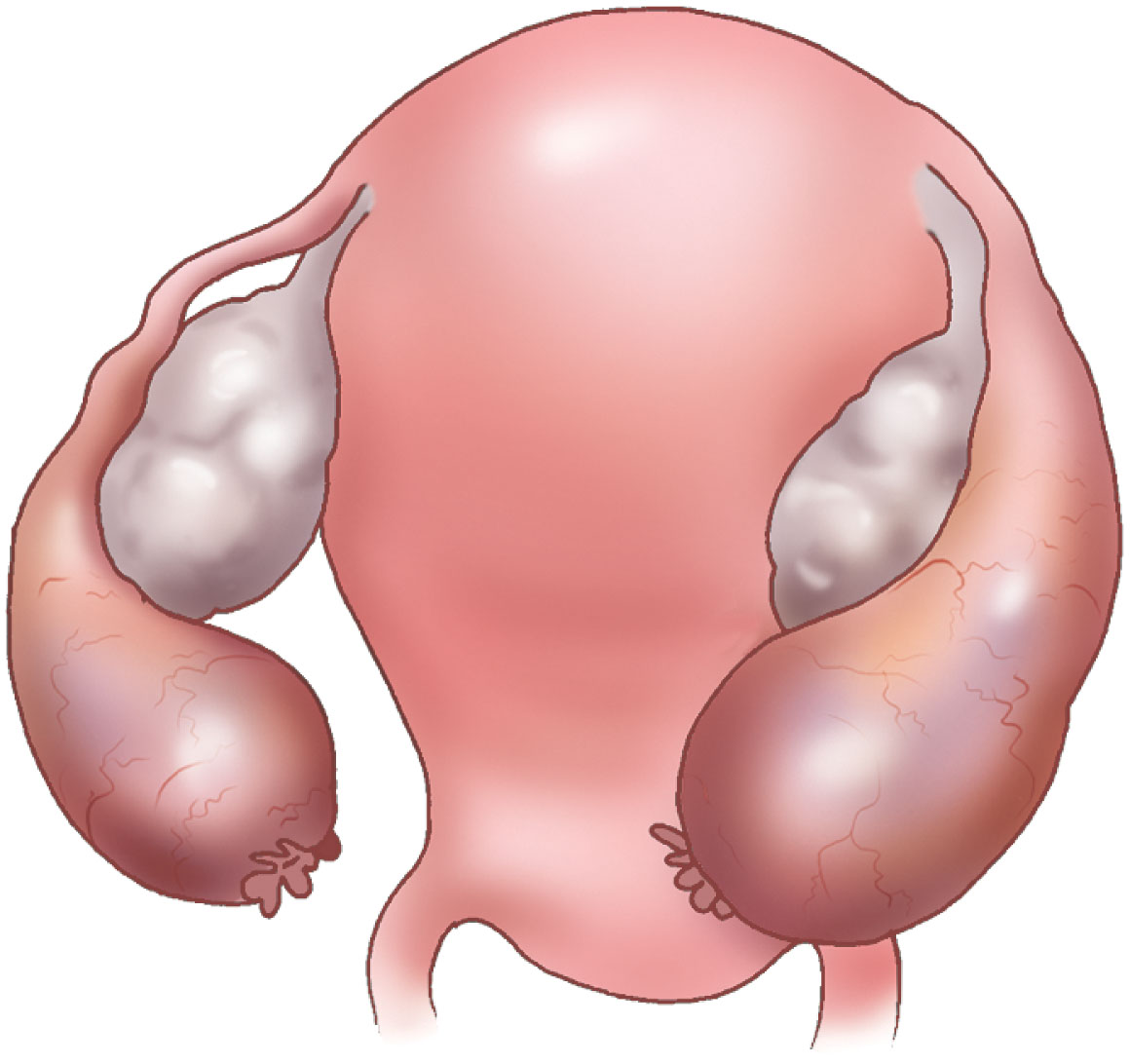
| Description | Clinical Findings | Sonographic Findings | |
|---|---|---|---|
| Salpingitis |
|
|
|
| Hydrosalpinx |
|
|
|
| Pyosalpinx | Retained pus in oviduct with inflammation |
|
|
Sonographically, the normal fallopian tube is generally not visualized unless fluid surrounds it. If outlined by ascitic fluid, it is a thin, less than 5-mm hypoechoic tissue band originating from the uterine fundus and can be imaged in an axial-coronal view. The sonographer can try to follow the dilated fallopian tube as it enters the cornu of the uterus (at the fundus). Careful oblique angulations of the transducer are necessary to trace the pathway of the tube. If fluid, pus, or products of conception (POCs) fill the tube, detection is easier. A pathologic state is probable if the lumen is outlined and shows irregularity and multiple diverticula.
If distinct tubular structures are instead seen, hydrosalpinx (dilated tubes) is diagnosed. Hydrosalpinx has variable presentations, from subtle dilated tubular structures to massive tortuous cystic areas. Although both tubes may be damaged, they may be asymmetric in size, with only the more dilated tube appreciated sonographically. Although contrast-enhanced salpingography is the definitive test, ultrasound appears to be accurate in identifying this process, particularly when performed transvaginally. Hydrosalpinx may present as echogenic fluid or fluid-debris levels ( Fig. 45.3 ), indicating infection (pyosalpinx).
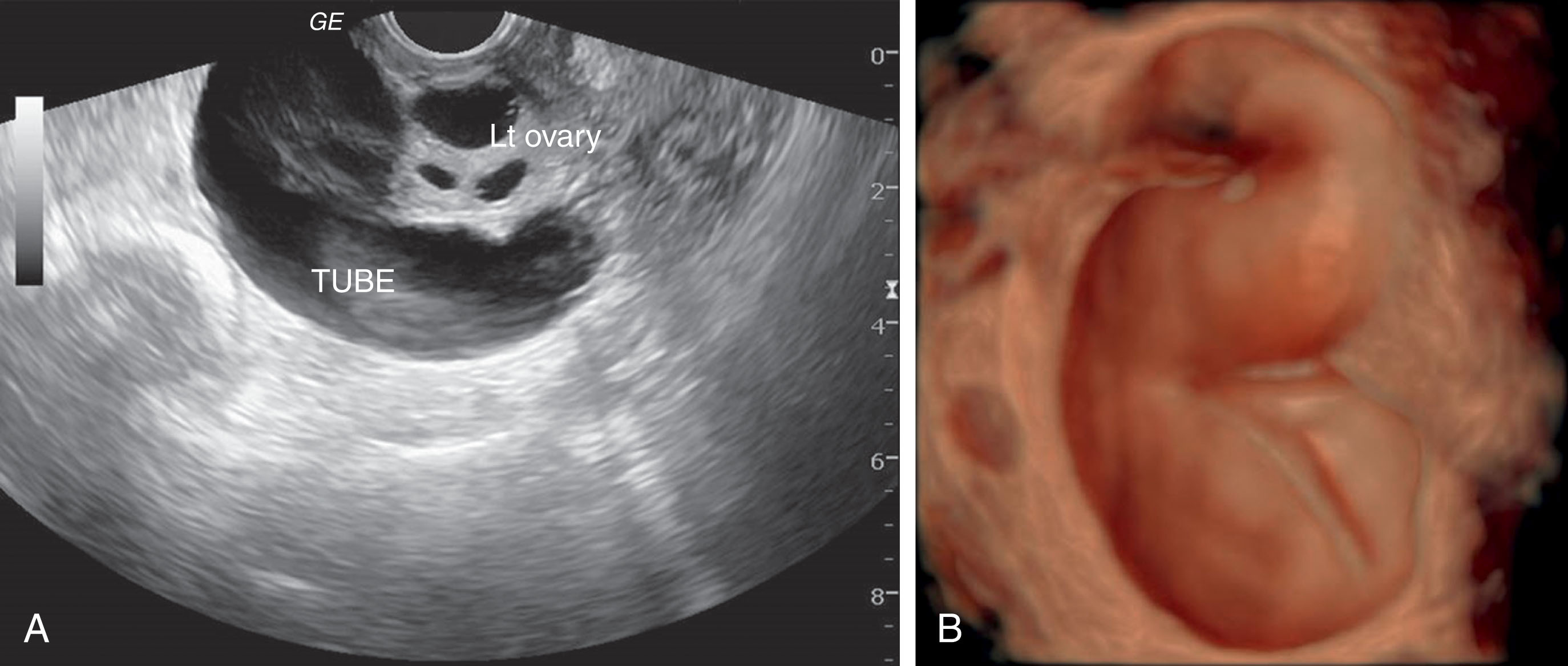
Severe and chronic pyosalpinx often contains thick, echogenic mucoid pus, which does not transmit sound as well as serous fluid or blood. A pyosalpinx may appear as a complex mass. A transvaginal examination is particularly useful for identifying the tubular nature and folds of the dilated tube, thus avoiding the mistaken diagnosis of a mass. Careful coronal scanning and rotation of the probe will help the sonographer to discern a dilated tube from an adnexal cyst.
Acute salpingitis is evident as a thick-walled nodular hyperemic tube ( Fig. 45.4 ). The dilated tubes usually surround the ovaries like two lunar crescents encircling the posterior surface of the uterus and filling the cul-de-sac.
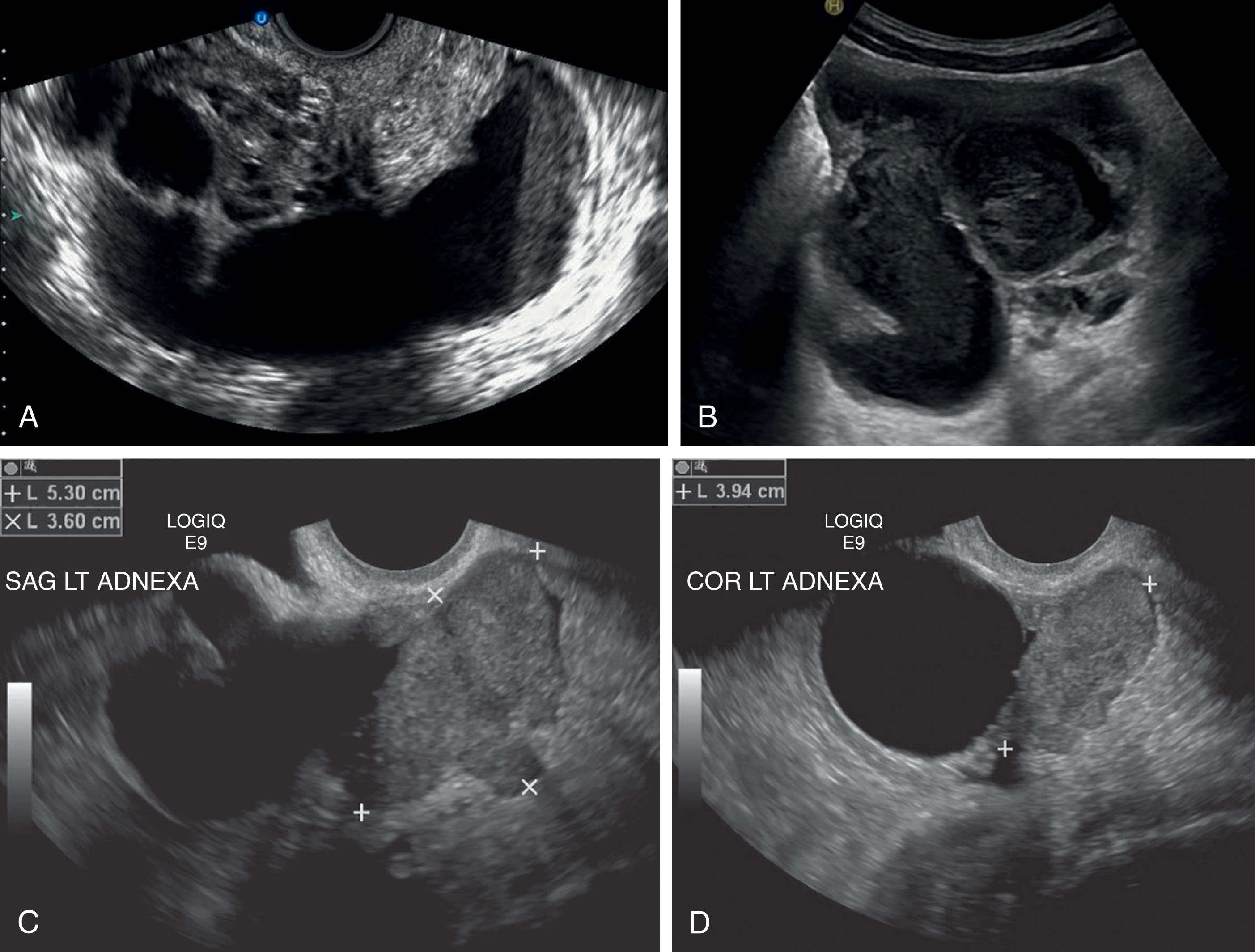
The sonographer should be sure not to confuse the dilated tube with a dilated ureter or prominent vessel. Occasionally, prominent blood vessels may be present in the adnexa. Although these may initially be misinterpreted as a hydrosalpinx, color or pulsed Doppler imaging will show blood flow in an adnexal blood vessel and no flow in a hydrosalpinx. Evaluation of the kidneys for possible hydronephrosis and trying to trace the dilated ureter to the bladder should help. The ovaries may be difficult to delineate because of surrounding tissue, edema, and pus. In addition to hydrosalpinx or pyosalpinx, sonographic findings of PID include fluid in the cul-de-sac ( Fig. 45.5 ), mild uterine enlargement, and endometrial fluid or thickening. Transabdominal and transvaginal sonography can reveal the presence of pelvic intraperitoneal fluid in the cul-de-sac. Pelvic fluid may frequently have internal echoes, septations, and fluid levels, a sign that the fluid is not simple but rather may be infected or hemorrhagic ( Fig. 45.6 ).
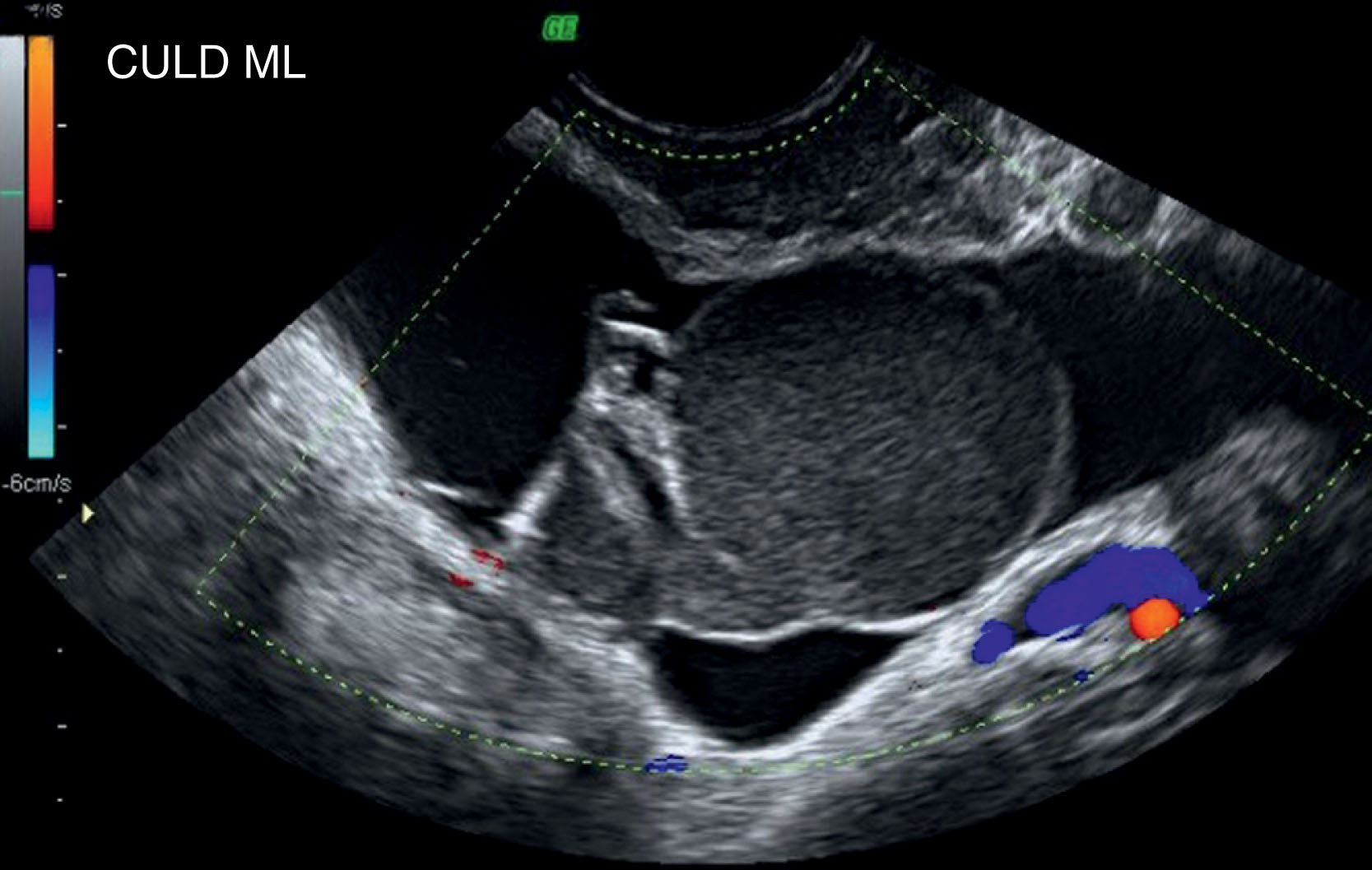
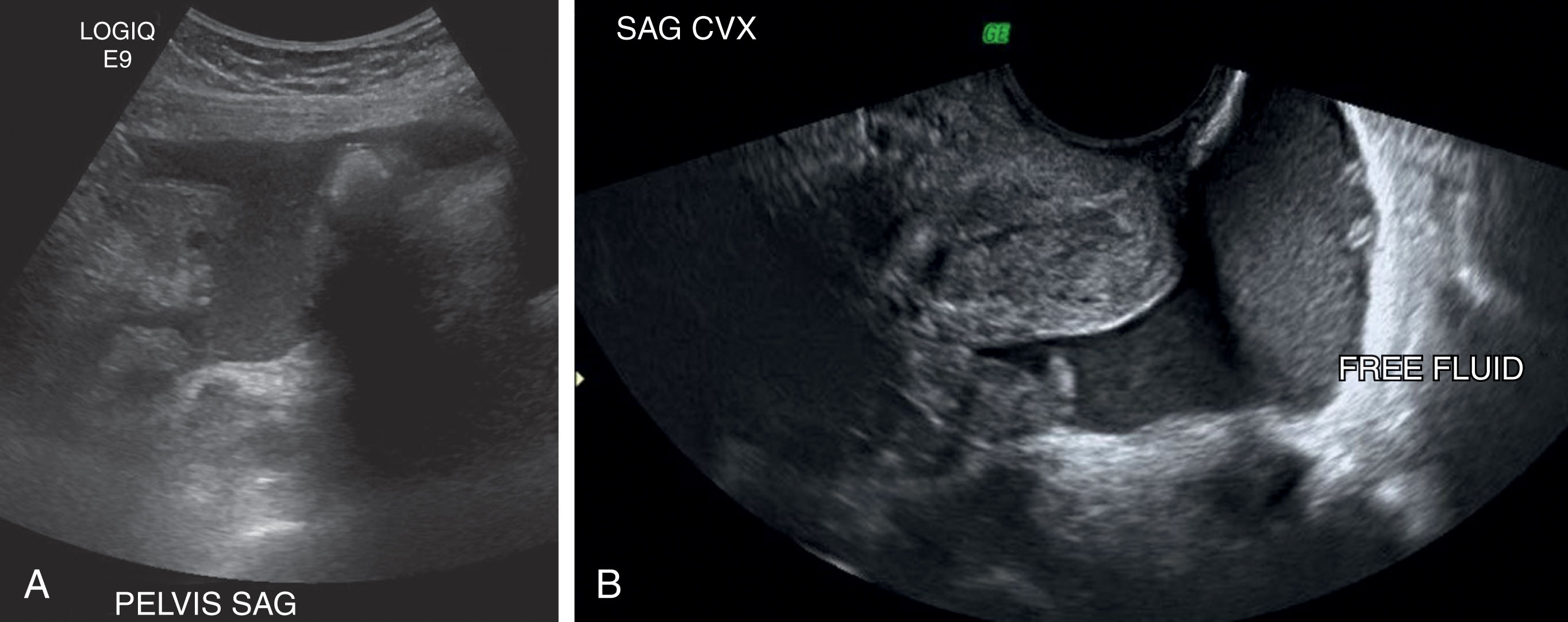
Any simple cyst that hemorrhages may appear as a complex mass. In patients of reproductive age, the classic differential diagnosis of a complex adnexal mass is hemorrhagic cyst, ectopic pregnancy, endometrioma, and PID. Dermoids and other benign tumors can appear in a similar fashion.
Become a Clinical Tree membership for Full access and enjoy Unlimited articles
If you are a member. Log in here